
As Opening Day nears, we’d like to tell you which teams improved the most this offseason -- sigh, fine, “won the winter,” if you must -- and we will. A few teams have done quite a bit to improve their odds. You can probably guess who some of them are. Skip down a few paragraphs if you just want to get to the good stuff. But, first briefly, we have to have that little discussion about what improving means.
What we’re going to do, as you’ll see below, is to take every team’s 2021 FanGraphs current projected WAR total and compare it to a version we saved in early November. That version came after qualifying offer decisions had been made (so Marcus Stroman and Kevin Gausman returned to the Mets and Giants, respectively), but after all free agents had been removed from their teams. That left us with a good look at "what did teams have at that point for 2021," with an entire winter's worth of moves yet to be made. (The one exception being Robbie Ray’s return to Toronto, because that happened shockingly early in the winter.)
That means we’re comparing apples to apples -- 2021 projected WAR now compared to 2021 projected WAR from five months ago -- and not 2021 projected WAR to 2020 actual wins, for a few reasons. Primarily, that’s because some teams, even if they’d done nothing at all, would have found some changes if only due to health; take the 26-34 Nationals getting only five innings from Stephen Strasburg in 2020. They’ll expect more from him in 2021, a lot more, and be better off for it. He was already under contract. Is that really going out to improve? We argue it’s not. His expected return is already accounted for, now as it was months ago, in projected WAR, which is why we’re using it.
The other issue to mention, and this is clearly a personal aesthetic preference that no one will ever come to consensus on, is whether bringing back your own free agents counts as improving. We argue that it does count; even if “Justin Turner, Dodgers third baseman” is the same situation we’ve had since 2014, there were also many months of the winter where any team could have signed him, leaving the Dodgers in the lurch. His contract had expired, and just because he’d played in Los Angeles last year and not Detroit or Miami or Arizona or anywhere else doesn’t make his addition any less impactful.
All that being said: This is what the improvement looked like. (Why are there more teams who improved than went the other way? Easy -- because our November comparison point was after all free agents had been removed from rosters. At that point in time, the available free agents were projected for about 119 WAR in 2021. Right now, the few remaining players are projected for less than 8 WAR.)
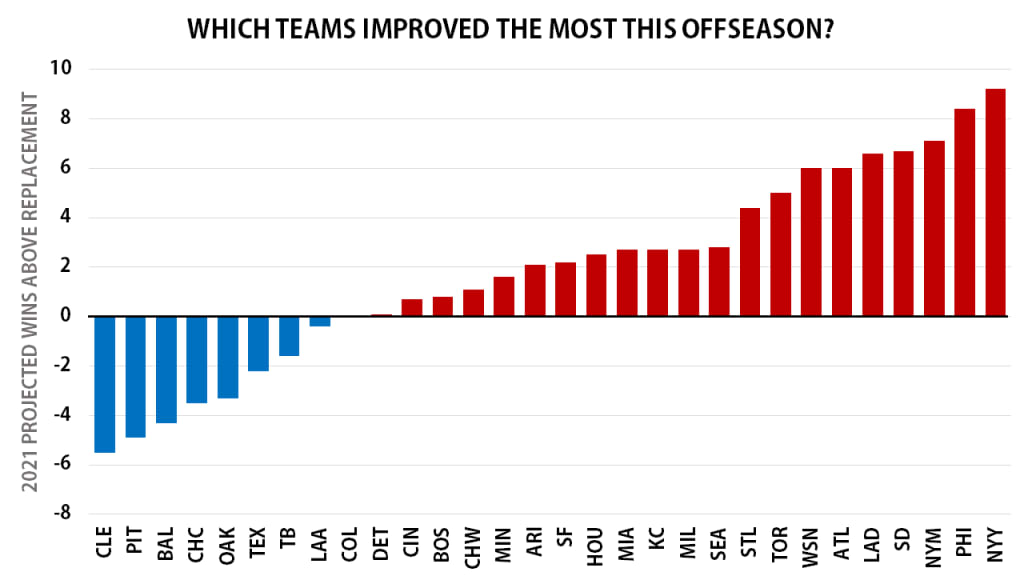
Let's take a look at the teams that improved by at least 5 WAR, and a few quick notes on some of the interesting teams that didn't.
+9.2 WAR, Yankees
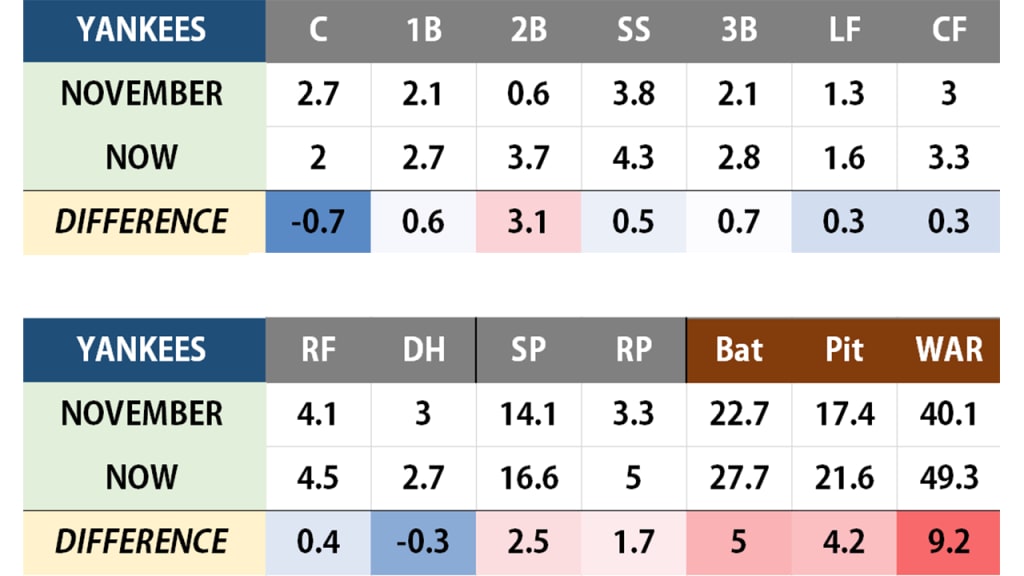
Is this surprising? Maybe it feels like the Yankees didn’t have the impactful offseason that you’d like -- they did see Masahiro Tanaka, James Paxton and J.A. Happ depart, though remember, we're comparing to the start-of-the-winter roster that had already lost them -- but re-signing DJ LeMahieu was a big deal, because back in November, they were projected to give more than 600 plate appearances at second base to Tyler Wade and Thairo Estrada. That was never going to happen, obviously, but that's the entire point here; signing LeMahieu back was a move that they needed to make, and one that took months to get done.
Meanwhile, no one argues the injury histories that Jameson Taillon and Corey Kluber bring. Projection systems, as we're fond of saying, are not prediction systems, and so if either or both gets hurt, it wouldn't be the most surprising thing in the world. But remember that what these additions also did was to push the other Yankees starters down in importance, adding depth.
Remember, Taillon wasn’t acquired until Jan. 24, and Kluber wasn’t signed until Jan. 27. In November, the sextet of Jordan Montgomery, Deivi García, Michael King, Nick Nelson, Jonathan Loaisiga and Clarke Schmidt were projected for 542 innings as starters. Right now, they’re projected for only 240 innings. Having that group as your next round of go-tos instead of your Opening Day dependables is a big deal.
+8.4 WAR, Phillies

Part of the reason we made sure to clarify that we think re-signing your own free agents is of importance is because that, in large part, is what the Phillies did. In November, the Phillies were projected to have the third-weakest catchers in baseball (sorry, Andrew Knapp and Rafael Marchan), because J.T. Realmuto was a free agent. Realmuto eventually re-signed in late January, and now, they’re projected to have the second-best catching in the game. How can you say that doesn’t matter?
You can say the same thing, if to a lesser extent, when Didi Gregorius returned to play shortstop, though his impact is less in who he replaced and more in what he let the team do. That's because in November, the Phillies were projected to have the 30th-best -- that's "worst" -- second-base situation in baseball, because it was almost entirely given to Scott Kingery, who has a career .284 OBP and isn't projected to do much more. (He didn't even make the Opening Day roster.) But now, Segura is at second, which gives Philadelphia the (tied for) 20th-best projection there. Is that great? No, of course not. Is it better than being last? Absolutely.
Unsurprisingly, also, the Phillies look to have a better bullpen. Not that it was ever going to be difficult to improve over last year's tremendously disappointing unit, but newcomers Archie Bradley, José Alvarado and Brandon Kintzler should all have their uses.
+7.1 WAR, Mets
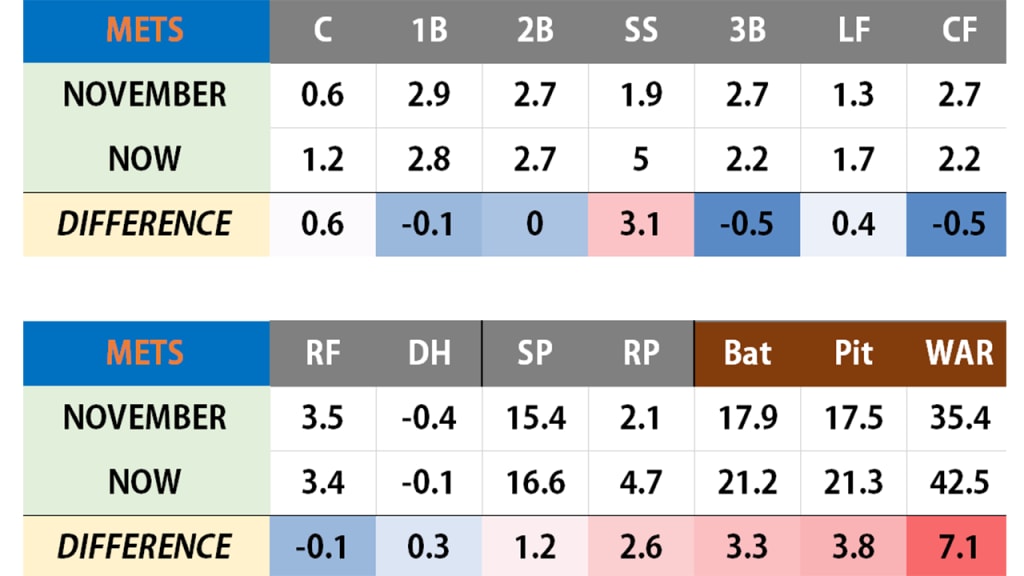
The Mets didn’t get George Springer or J.T. Realmuto, but they did get Francisco Lindor. It's important to remember that he's not replacing no one at shortstop, because there were things to like about each of Andrés Giménez and Amed Rosario, and so the November Mets were projected to have the 21st-best shortstops. Now, though, they're all the way up to third. It's a big deal. They improved a little behind the plate, too, though the projections don't know entirely what to do about James McCann, who had nearly 1,700 unimpressive plate appearances in his first five years (76 OPS+) and then 587 better ones in the last two (113 OPS+). He'll be better on both sides of the ball than Wilson Ramos, anyway.
They take a bit of a step back in center field -- the projections are not fans of either Kevin Pillar and Albert Almora Jr., who each might take playing time away from Brandon Nimmo -- but what's clear here is that in addition to shortstop and catcher, the Mets improved their pitching depth as well. That's taking into account Carlos Carrasco's hamstring injury, which will keep him out for several weeks, because they'll still likely get 100 or so good innings from him, as well as contributions from newcomers Trevor May, Taijuan Walker, Joey Lucchesi and Aaron Loup.
+6.7 WAR, Padres
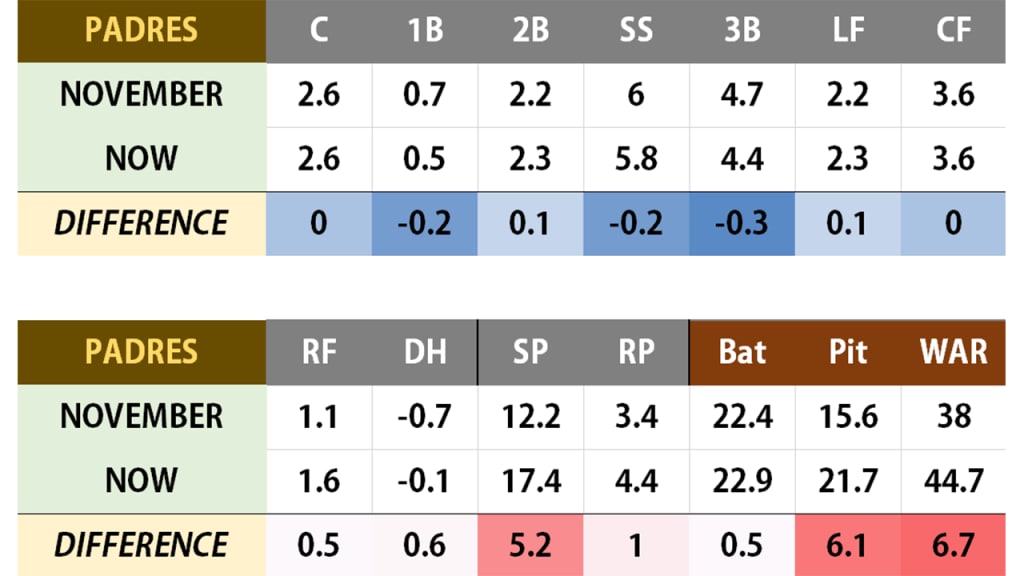
That chart above really tells the story of how and where the Padres -- who were, we cannot stress enough, already very good -- made their big moves this winter. Did they improve their lineup? A little, not a lot; not that it's not nice to add Ha-Seong Kim and bring back Jurickson Profar, but the lineup was going to be good and strong and deep regardless, with most of the same cast as you saw in 2020.
The pitching, though? We hardly need to remind anyone that San Diego traded for Yu Darvish and Blake Snell and Joe Musgrove, but indeed they did, as well as signing veteran relievers Mark Melancon and Keone Kela to one-year deals. In November, the Padres had the 13th-best rotation, as Zach Davies, Dinelson Lamet, Chris Paddack and Adrian Morejon were projected to be the top four starters. Now, they're all the way up to No. 1 , because the new trio are in, Davies is gone, and Lamet, Paddack and Morejon are all required to shoulder less of the workload. We knew San Diego would get at least one starter. We didn't think it'd get three -- three good ones, to be clear -- and the effects here are clear.
+6.6 WAR, Dodgers

Speaking of an already-good NL West team that somehow managed to get better: the Dodgers. Part of this, obviously, was that when the offseason began, they didn't really have a third baseman, Turner having gone off to a surprisingly lengthy free agency. (The Los Angeles third-base group, at the time seemingly led by Edwin Ríos, ranked 27th in November's rankings. They're now ninth.) Otherwise, the position-player group is so deep that the departures of longtime role players like Enrique Hernández and Joc Pederson didn't really move the needle; this club is well-equipped to handle it.
There was another big add here, of course, and this time from a new face, as reigning NL Cy Young Award winner Trevor Bauer signed with the Dodgers in February. In addition to the value he brings -- he's projected for 4.4 WAR himself -- he takes some of the workload off others. David Price, for example, was projected to need to throw 144 innings back in November. Now, it's only 62.
This was already clearly the best team of 2020. It's almost unfair they've now gotten even better.
+6 WAR, Braves
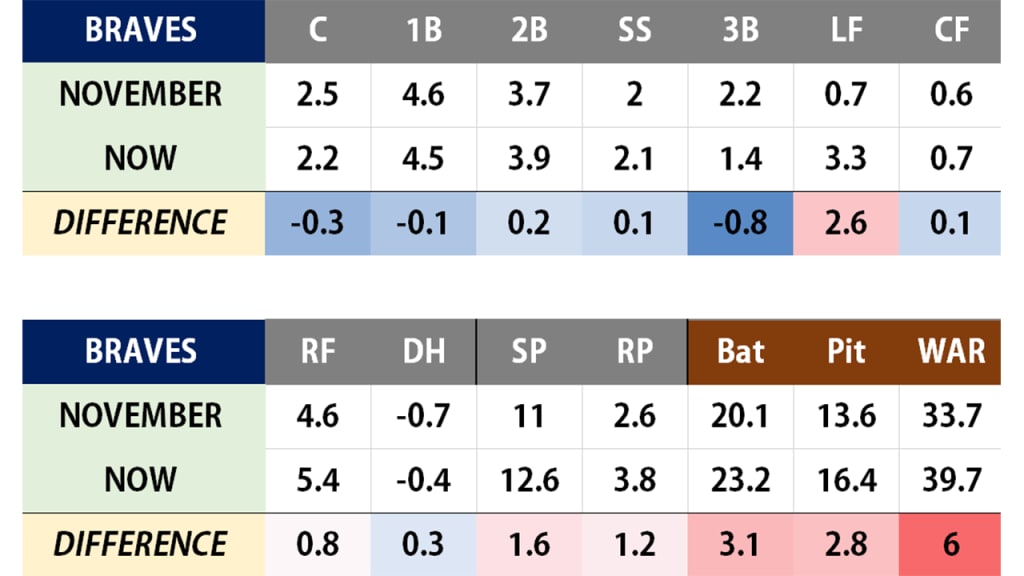
The Braves, for much of the winter, simply didn't have a left fielder. That's not hyperbole, really; Marcell Ozuna was a free agent, and they non-tendered Adam Duvall. As things stood months ago, they were going to be giving a whole lot more playing time to Ender Inciarte than anyone was comfortable with. Of course, Ozuna did eventually return in February, and a situation that once looked dire now appears to be a strength, since Atlanta's left fielders are now ranked as baseball's second best.
The projections now include an increase in right-field playing time for Ronald Acuña Jr., now that he'll be less likely to appear in center field to help rookie Cristian Pache, since Ozuna's return pushes Inciarte to the bench. In the rotation, the arrivals of Drew Smyly and Charlie Morton add needed depth, taking some weight off the likes of Bryse Wilson and Kyle Wright.
+6 WAR, Nationals
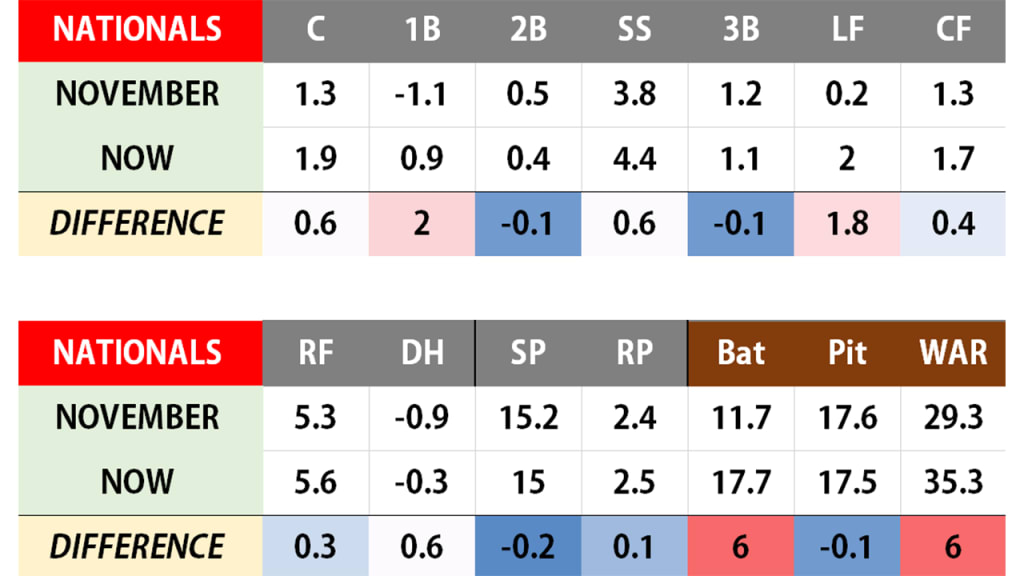
It's not hard to see the two main Washington additions here, is it? At first base, the Nationals were the second weakest at the start of the offseason, given that four of the six men who played there in 2020 (Eric Thames, Asdrúbal Cabrera, Howie Kendrick and Brock Holt) were gone, and if the season had begun then, first base would have been staffed by Jake Noll, Starlin Castro and Yasmany Tomás. (Note the negative-1.1 WAR projection.) No longer, not after trading for Josh Bell and welcoming back franchise icon Ryan Zimmerman. It's not a great duo -- ranked 17th among first basemen -- but it's a whole lot better than it looked in November.
It was similar in left field, which was left vacant by Juan Soto's move to right. The November Nationals were going to give more than 550 plate appearances to Andrew Stevenson and Yadiel Hernández; the March Nationals have Kyle Schwarber, which is a nice upgrade. Interestingly, the pitching projection is unchanged, despite some turnover. That's because the projections just don't see a lot to like about Jon Lester, and the value brought by Brad Hand is somewhat being canceled out by the injuries -- and therefore, decreased innings estimates -- to Will Harris and Tanner Rainey.
+5 WAR, Blue Jays

Obviously, adding George Springer boosts that center-field projection, though perhaps slightly less than you think, because unlike some of the other areas we've noted above where the team had no viable option to start the winter, the November Blue Jays had Randal Grichuk, who's a perfectly capable player if clearly not Springer's equal.
If you're wondering why the addition of Marcus Semien isn't reflected quite so clearly, it's because his arrival to play second base moved around some dominoes. Right now, Toronto has the fourth-best group of second basemen, but that's only a step up from "fifth best" in November, because Cavan Biggio is pretty good. Instead, the real value add here is at third base, where the Blue Jays jumped from 19th to 10th, now that Biggio will shift there to make room for Semien. Meanwhile, the various pitching moves they've made have added a little projected value, but not a ton, just because most of the imports add more "depth" than "upside."
Other notes ... Why didn't the Rockies take a larger step back after trading Nolan Arenado? Because while they're obviously worse off at third base (-3.4 WAR since November), their previously 30th-ranked first-base and left-field situations received minor boosts after adding C.J. Cron, taking time away from Josh Fuentes' low-impact bat, and subtracting Ian Desmond, which was worth a combined +2.7 WAR) ... Why didn't the White Sox improve more after adding Liam Hendriks and Lance Lynn? Partially because the Adam Eaton signing didn't move the needle, but also because losing Eloy Jiménez for perhaps the entire year crushes their left-field projection (it dropped them from third to 27th) ... Why aren't the Angels considered to have had a better winter? Because they didn't actually do a whole lot; new additions like José Iglesias, Dexter Fowler and Alex Cobb aren't needle movers, so if they do indeed get better, it's going to be because of internal improvements from holdovers like Shohei Ohtani and Jared Walsh.
